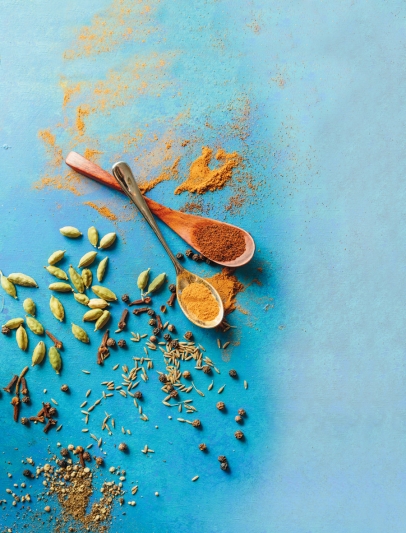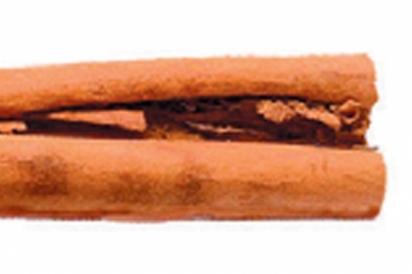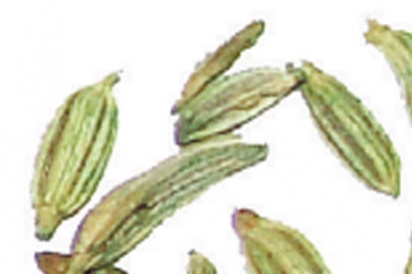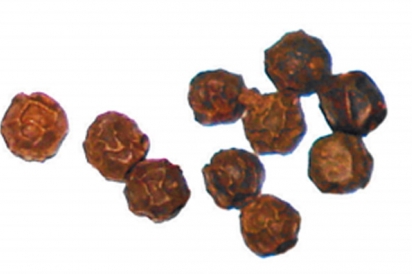'Tis the Seasoning
A world of spices enhances our cuisines and our health
My love of spices comes from my upbringing in India, where I was exposed to more than 150 different sweet and savory spices in our cooking. Spices have been integrated into our diets for thousands of years and we have relied on their flavors and health benefits. I remember my mother’s kitchen exuding heavenly aromas every single day, and I was hooked on spices not just as a cook (and a connoisseur of good food) but also as a budding scientist with a strong desire to explore what makes them so beneficial.
Being a researcher by nature, I became interested in spices early on in my life and since becoming a biology professor I have started testing the impact of some of the spices and oils in my research involving women’s cancer cells (ovarian, uterine, breast and cervical cancers). I’m exploring the effect of reagents such as curcumin (found in turmeric), ginger oil and natural extracts on the growth of these cells. Although results are exciting in terms of showing a decrease in the growth of these cells, much more research is needed before any conclusive statements can be made.
For me, spices conjure an image of exotic, aromatic and colorful food ingredients that lend a cuisine its distinctive flavor and personality. Each spice has its own nature and mood: some soothing, some warming and some cooling.
Our bodies rely on spices for their proper dietary balance, while our tongues relish spices for their flavors. No matter which part of the world you live in, using spices has become second nature. During the winter in Ventura County (and anywhere, really) eating spices is recommended for their heating properties.
The onset of winter brings problems to the human body such as hypothermia (particularly in older people) and low immunity. While cozy winter nights spent with friends and family reflect quality time, winter spices are an added seasoning to evoke feelings of joy, warmth and peace.
Of the many that are good for you, cinnamon, cardamom, cloves, cumin and black pepper are the five prime spices you can use in abundance to ward off winter’s chill. According to the ancient science of Ayurveda, warming spices help to raise the inner body temperature and give a feeling of comfortable heat. The heat or fire in our body is important for proper digestion, so in the months of winter when our digestion gets a bit lazy, these spices help a lot.
I’ll get to why, but first a bit about spices in general.
The origin of the word “spice” is the Old French word espice connected to the Latin word spec, referring to “appearance of a specific kind.” These are aromatic fruits, flowers, bark, roots, buds, seeds and berries. They are mainly associated with cooking but are also used in medicine, as natural dyes, and in the perfume and cosmetics industries. Spices have been used for thousands of years throughout Asia, Arabia and the Mediterranean regions. Once valued as highly as gold, they were much sought-after in the West and the quest for spices influenced the course of history. Even though today the spice wars have ceased, spices still play a major role in the economies of many countries.
CINNAMON
Cinnamon is the bark of several species of the genus Cinnamomum. It was used by the Egyptians 3,500 years ago. Although originally from Sri Lanka, it is now grown in India, Brazil, West Indies and Indian Ocean islands. The cinnamon bark contains cinnamaldehyde, while the cinnamon leaf contains eugenol; both contribute to its pungent taste.
Eugenol has local anesthetic and antiseptic properties and is used in dental and gum treatment procedures. The bark gets rid of bad breath and is useful in abdominal pain and indigestion. The leaf functions as an appetite stimulant, a digestive aid, blood purifier and diuretic. (Cinnamon leaves are commonly called Indian bay leaves, available at Indian grocers.)
Both the bark and the oil have astringent, stimulant, anti-infective, anti-fungal, anti-diabetic, immunomodulatory and cholesterol-lowering properties.
Cinnamon stick is popularly used as a condiment in rice in the eastern part of the globe, but can also be used for making cinnamon tisane, flavoring your oatmeal or spicing up your coffee. We think of ground cinnamon as a sweet spice used to make rolls, cakes, custards and doughnuts, but it can also be used in soups and braises to lend some warmth.
CARDAMOM
Cardamom is one of the most ancient and highly valued spices in the world. It is made from the seeds of several plants in the genera Elettaria and Amomum and primarily comes from India, Sri Lanka, Bhutan, Indonesia and Nepal.
It is used as a deodorant, for fighting nausea and as a digestive aid. It also provides heartburn relief, is an appetite stimulant and relieves constipation. If you have a cold, cardamom can help you get rid of phlegm and chest congestion. Chewing a few seeds freshens your breath, particularly if you’ve eaten a lot of garlic. It is known to stimulate menstruation so is not recommended for pregnant women.
In India, cardamom is one of the main ingredients in curry powder and the spice mix garam masala.
Add cardamom powder to hot milk on cold winter nights, or add it to tea, apple cider, oatmeal and hot stews. Cardamom is rich in magnesium, manganese and zinc.
CLOVES
Cloves are unopened flower buds of a small evergreen tree in the Myrtaceae family. Although native to the Maluku Islands in Indonesia, they are commercially harvested primarily in Bangladesh, Indonesia, India, Madagascar, Zanzibar, Pakistan, Sri Lanka and Tanzania.
The flower buds are harvested as they turn from green to pink and are then dried, cleaned, graded and packaged. Clove oil, obtained by extracting buds, stems and leaves, is a source of eugenol, which is used in perfumes, soap making and dentistry.
Cloves have appetizer, digestive, aphrodisiac and diuretic properties. They are useful in bronchial asthma, fevers and for deadening toothaches (its essential oil is an antiseptic and analgesic). Diluted oil of cloves can be used as a mouthwash or gargle.
Cloves can be used in sweet or savory dishes, but have to be used sparingly due to their strong, pungent taste and aroma.
Cloves are often used when mulling wine or apple cider, and in rice dishes, curries, pies, soups, pickles and fruitcakes in Southeast Asia.
CUMIN
Cumin is the dried seed of the herb Cuminum cyminum, a member of the parsley family. A flowering plant in the family Apiaceae, its seeds are used in the cuisines of many different cultures, in both whole and ground form, particularly native to south Asia and the Mediterranean.
Cumin is an appetite stimulant and has digestive, anti-parasite and diuretic properties. It is a good source of vitamins A, C, E and B6, thiamine, riboflavin, niacin and minerals like iron, manganese, copper, calcium, magnesium, phosphorous and potassium. Although cumin seeds are regarded as safe in foods, cumin oil may have toxic effects (convulsant and irritative) in high concentrations.
Cumin is essential in garam masala and curry powder mixes. It is used in pickles, relishes and salads, couscous and vegetable dishes. In India, it is taken as a remedy for diarrhea, flatulence and indigestion.
It’s a good idea to dry-roast a small amount of cumin seeds and then grind them in a spice grinder. Toasted cumin seeds have an earthy flavor and develop more floral notes when they are ground. The spice is popularly used in legume dishes (lentils, garbanzos and black beans), rice and vegetables.
BLACK PEPPER
Black pepper comes from the plant Piper nigrum.
Black pepper is the unripe but mature fruit (called a drupe), which has been removed from vines and piled in heaps in full sun to initiate enzymatic fermentation to darken the fruits (known as peppercorns) and develop flavor.
It is the most widely used spice in the West, though originally it came from the monsoon forests of the Malabar Coast in southwest India. It was once as expensive as gold.
Peppers contain the alkaloid piperine, which is responsible for black pepper’s distinctive biting quality. It has a warm woody smell and tastes neither sweet nor savory—just pungent. Piperine has many pharmacological effects and several health benefits, especially against chronic diseases, such as reducing insulin-resistance, and has anti-inflammatory effects.
It has been found to be useful in healing skin diseases, indigestion, liver disorders, abdominal pain and fevers. Black pepper is an excellent source of manganese and vitamin K and a very good source of copper and dietary fiber. Black pepper is a carminative, so it discourages intestinal gas from forming; the outer layer of the peppercorn also aids in the breakdown of fat cells.
A recent study revealed that pepper’s extracts show anticancer activity against colorectal cancer.
Black pepper can be used in virtually any dish on this planet. It is the most beloved of all spices. But keep the pepper coarse—the more finely ground black pepper is, the more it can irritate your throat.
Peppercorns are used whole to flavor stocks and liquids and crushed coarsely when adding to dry mixtures or marinades.
These are not the only winter spices that are beneficial for providing some much-needed warmth to your body but they do rank among the top. So go on—indulge this season in the aromas and exotic glory of these lovely ingredients and make your cuisine a sure success.
References:
1: Gruenwald J, Freder J, Armbruester N. Cinnamon and health. Crit Rev Food Sci Nutr. 2010 Oct; 50(9):822-34. doi: 10.1080/10408390902773052. Review. PubMed PMID: 20924865.
2. Bandara T, Uluwaduge I, Jansz ER. Bioactivity of cinnamon with special emphasis on diabetes mellitus: a review. Int J Food Sci Nutr. 2012 May; 63(3):380-6. doi: 10.3109/09637486.2011.627849. Epub 2011 Oct 19. Review. PubMed PMID: 22007625.
3. Kawatra P, Rajagopalan R. Cinnamon: Mystic powers of a minute ingredient. Pharmacognosy Res. 2015 Jun;7(Suppl 1):S1-6. doi: 10.4103/0974-8490.157990. Review. PubMed PMID: 26109781; PubMed Central PMCID: PMC4466762.
4. Rastogi S, Pandey MM, Rawat AKS. Spices: Therapeutic Potential in Cardiovascular Health. Curr Pharm Des. 2017;23(7):989-998. doi: 10.2174/1381612822666161021160009. PubMed PMID: 27774899.
5. Daneshi-Maskooni M, Keshavarz SA, Mansouri S, Qorbani M, Alavian SM, Badri-Fariman M, Jazayeri-Tehrani SA, Sotoudeh G. The effects of green cardamom on blood glucose indices, lipids, inflammatory factors, paraxonase-1, sirtuin-1, and irisin in patients with nonalcoholic fatty liver disease and obesity: study protocol for a randomized controlled trial. Trials. 2017 Jun 7;18(1):260. doi: .1186/s13063-017-1979-3. PubMed PMID: 28592311; PubMed Central PMCID: PMC5463368.
6. Jessica Elizabeth T, Gassara F, Kouassi AP, Brar SK, Belkacemi K. Spice use in food: Properties and benefits. Crit Rev Food Sci Nutr. 2017 Apr 13;57(6):1078-1088. doi: 10.1080/10408398.2013.858235. Review. PubMed PMID: 26560460.
7. Chaieb, K., Hajlaoui, H., Zmantar, T., et al. (2007). The chemical composition and biological activity of clove essential oil, Eugenia caryophyllata (Syzygium aromaticum L. Myrtaceae): a short review. Phytother Res, 21(6), 501-6.
8. Tsuchiya H. Anesthetic Agents of Plant Origin: A Review of Phytochemicals with Anesthetic Activity. Molecules. 2017 Aug 18;22(8). pii: E1369. doi: 10.3390/molecules22081369. Review. PubMed PMID: 28820497.
9. Bower A, Marquez S, de Mejia EG. The Health Benefits of Selected Culinary Herbs and Spices Found in the Traditional Mediterranean Diet. Crit Rev Food Sci Nutr. 2016 Dec 9;56(16):2728-46. doi: 10.1080/10408398.2013.805713. Review. PubMed PMID: 25749238.
10. Agah S, Taleb AM, Moeini R, Gorji N, Nikbakht H. Cumin extract for symptom control in patients with irritable bowel syndrome: a case series. Middle East J Dig Dis. 2013 Oct;5(4):217-22. PubMed PMID: 24829694; PubMed Central PMCID: PMC3990147.
11. Sowbhagya HB. Chemistry, technology, and nutraceutical functions of cumin (Cuminum cyminum L): an overview. Crit Rev Food Sci Nutr. 2013;53(1):1-10. doi: 10.1080/10408398.2010.500223. Review. PubMed PMID: 23035918.
12. Derosa G, Maffioli P, Sahebkar A. Piperine and Its Role in Chronic Diseases. Adv Exp Med Biol. 2016;928:173-184. Review. PubMed PMID: 27671817.
13. Butt MS, Pasha I, Sultan MT, Randhawa MA, Saeed F, Ahmed W. Black pepper and health claims: a comprehensive treatise. Crit Rev Food Sci Nutr. 2013;53(9):875-86. doi: 10.1080/10408398.2011.571799. Review. PubMed PMID: 23768180.
14. Prashant A, Rangaswamy C, Yadav AK, Reddy V, Sowmya MN, Madhunapantula S. In vitro anticancer activity of ethanolic extracts of Piper nigrum against colorectal carcinoma cell lines. Int J Appl Basic Med Res. 2017 Jan-Mar;7(1):67-72. doi: 10.4103/2229-516X.198531. PubMed PMID: 28251112; PubMed Central PMCID: PMC5327611.









